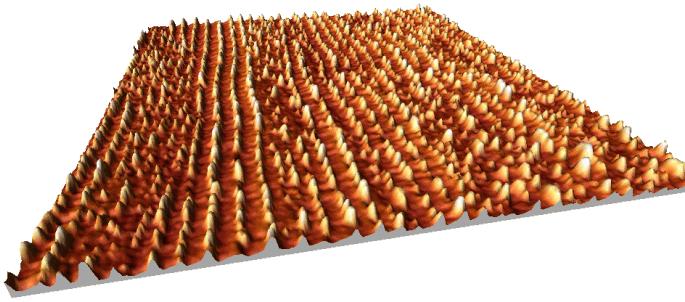
AFM
image of quantum dots aligned along macrossteps from step bunching.
Low dimensional structures show several interesting effects due to the breaking of the bulk symmetry and confinement. Resonances induced by surface states and surface phonons can enhance signals by two orders of magnitude or make signals appear at forbidden energies.
Self-organized formation is the main method to form the low-dimensional structures. To understand and concequently to influence the mechanism of self-organized formation of quantuum dots in III-V semicondutors in Metal-Organic Vapour Phase Epitaxy (MOVPE) is one of the major research topics in our group. Other related topics are step-bunching or the formation of quantuum wires.
Microstructures are also formed during the adsorption of adsorbates on clean surfaces in Ultra-High Vaccum. Here the focus lies on Raman scattering, together with electron diffraction. Even clean surfaces can have detectable surface phonons at energies different from bulk phonons. Currently the surface phonons of low-dimensional structures such as 1D-In nanowires on Si are studied in more detail.
Using a new setup all available optical techniques (Raman, Reflectance Anisotropy Spectroscopy (RAS), Ellipsometry) work between high (1000K) and low temperatures (20K) on the same surface in the same machine. This allows us to investigate phase transitions such as charge density waves in the quasi-1D-Structures. Ex-situ the surfaces are characterized by Atomic Force Microscopy (AFM), Electron Microscopy, Photoluminescence, and Angle Resolved ligh Scattering (ARS).
AFM image of quantum dots aligned along macrossteps from step bunching.